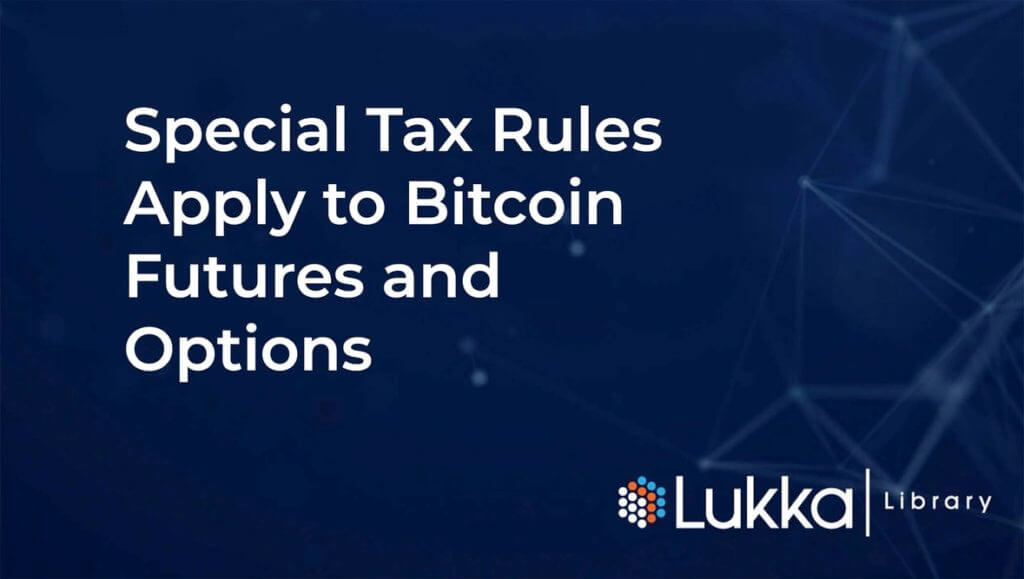MEMORANDUM
Date: January 31, 2020
To: Lukka Library
From: Andrea S. Kramer
Re: Special Tax Rules Apply to Bitcoin Futures and Options and Might Apply to Positions in Other Virtual Currencies in the Future*
As a general rule, taxpayers are not taxed on gains in virtual currency positions until the positions are sold, exchanged, or otherwise disposed of. Special tax rules can apply, however, to require taxpayers to treat their gains on certain virtual currency positions as taxable even though they still hold their positions. This is referred to as marking their positions to market for tax purposes.
Section 1256 Contracts Defined
Section 1256 Contracts are defined to include regulated futures contracts (RFCs) and nonequity options, both of which are defined below.
Regulated Futures Contracts
RFCs must meet two requirements. First, the amounts required to be deposited or allowed to be withdrawn on the contracts must follow a system of marking to market.2 Second, the contracts must be traded on (or made subject to the rules of) a qualified board or exchange3 (QBE), which includes a registered national securities exchange and a domestic board of trade (designated as a contract market by the CFTC). Bitcoin futures are subject to a system of daily marking to market, and the CME is a QBE. As a result, the CME’s Bitcoin futures are RFCs. It is important to note that not all U.S. securities exchanges and commodities exchanges that trade virtual currency positions will qualify as QBEs. This means that the first step is to determine whether a particular exchange is a QBE.
Nonequity Options
Nonequity options must meet a circular definition that involves the definitions of “listed options” and “equity options.”4 For these purposes, a listed option is any option that is traded on or subject to the rules of a QBE.5 And a nonequity option is on products other than individual stocks or narrow-based stock indexes.6 Working our way through this circular definition, nonequity options must be traded on a QBE and can be options based on convertible virtual currency. The CME’s Bitcoin options meet this definition and qualify as nonequity options.
Other Virtual Currency Derivatives Are Not Section 1256 Contracts
At the date of this writing, only the CME’s Bitcoin futures and options qualify as Section 1256 Contracts.7 No other virtual currency derivatives currently meet this definition. All other virtual currencies and derivatives will not be marked-to-market annually and remain subject to the general tax rules that apply to capital or ordinary assets. But what about the possibility of futures and options on Ether or other activity traded virtual currencies? They could become Section 1256 contracts in the future.
Section 1256 Treatment
As Section 1256 Contracts, the CME’s Bitcoin futures and options are subject to the Mark-to Market Rule and the 60/40 Rule.8 Section 1256 is not elective. Transactions that meet these definitions are subject to these two rules, discussed in what follows.
The Mark-to-Market Rule
The Mark-to-Market Rule provides that Section 1256 Contracts open on the last day of the taxable year are market-to-market, that is, treated as if they were sold on that date. All unrecognized gains and losses are taken into account. In other words, open Section 1256 futures and options are treated as if they were sold for their fair market value on the last business day of the taxable year. The fair market value of such futures or options is their settlement prices. For Bitcoin futures and options, for example, their settlement prices are determined by the CME on the last business day of the taxable year.9 All gains and losses are tallied up and used to compute taxable income.
When taxpayers terminate Bitcoin futures or options during the year (by offset or otherwise), these contracts are taxed at their sale or close-out price.10
Because taxes are paid on recognized and unrecognized gains and losses, taxpayers holding Bitcoin futures and options can be required to pay tax on gain that, in fact, they may never actually realize.11 If they continue to hold contracts that were marked-to-market at year end, gains and losses realized in a subsequent tax year are adjusted to reflect gains and losses taken into account in the preceding taxable year.12 The Mark-to-Market Rule can, therefore, distort income and cause economic hardship if gains that were reported in the first year do not materialize in a subsequent tax year.
The 60/40 Rule
Under the 60/40 Rule, CME’s Bitcoin futures and options that are capital assets in the taxpayers’ hands are taxed as 60% long-term and 40% short-term capital gain or loss. The 60/40 Rule applies without regard to the length of time taxpayers hold such positions, meaning that the capital gain holding period requirement is eliminated for Section 1256 Contracts. Futures or options that are ordinary assets in the taxpayers’ hands are not eligible for 60/40 treatment even though they remain subject to mark-to-market.13 The Mark-to-Market Rule applies to all Section 1256 Contracts, without regard to whether they are ordinary or capital, unless the taxpayer is a hedger that made a valid hedge identification.
Straddles Consisting Only of Bitcoin Futures and Options
If taxpayers hold tax straddles that consist only of Bitcoin futures and options, the general straddle rules of I.R.C. § 1092 do not apply.14 This is because the Mark-to-Market Rule taxes all gains and losses on Section 1256 Contracts as of the last business day of the taxable year, preventing taxpayers from deferring their gains or accelerating their losses. For a discussion of the straddle rules, see McDermott’s Memorandum, “When Virtual Currency Positions are Subject to the Straddle Rules.”
Straddles Consisting of Bitcoin Futures or Options as Well as Other Positions
Taxpayers who hold Bitcoin futures or options might also hold actual Bitcoins or other Bitcoin derivatives. If the taxpayers’ positions meet the requirements of a straddle (offsetting positions in actively traded personal property), their straddles are subject to the straddle rules. Straddles that include both Section 1256 Contract positions and non-Section 1256 Contract positions are treated as mixed straddles, subject to various elections available to mixed straddles. For a discussion of the straddle rules, see McDermott’s Memorandum, “When Virtual Currency Positions Are Subject to the Straddle Rules.”
Special Loss Carryback Rules
Taxpayers who are not corporations, trusts, or estates can elect special loss carryback rules for losses on Section 1256 Contract that qualify for 60/40 treatment. Eligible taxpayers can use their section 1256 losses incurred in one year to reduce income generated on such contracts in prior tax years. This carryback rule provides a form of income averaging not available to other taxpayers. Taxpayers can carry net Section 1256 Contract losses back to each of the three preceding years and apply the losses against net Section 1256 Contract gain recognized in those prior years.15
Losses that are carried back are treated as if 60% were long-term and 40% were short-term.16 Carry-back losses cannot be used to increase or produce a net operating loss for the prior taxable year.17 Such losses are carried back to the earliest of the three preceding taxable years in which there is a net Section 1256 Contract gain.18 Any portion of the loss not absorbed in the earliest year can then be carried forward to the next taxable year and, if any loss remains, to the next (most recent) taxable year.19 Any net Section 1256 Contract loss carried forward from the first carry-back year is again recharacterized as 60% long-term and 40% short-term capital loss.20 The loss carryback election is quite complicated in its application, applying only after netting Section 1256 Contracts losses with unrelated capital gains and losses.
Section 1256 Contracts are potentially relevant to taxpayers buying, selling, and holding Bitcoin futures and options. Such contracts currently trade on the Chicago Mercantile Exchange (CME).1 As discussed in this Memorandum, Bitcoin futures and options currently qualify as Section 1256 Contracts and, therefore, are subject to the special tax timing and tax character rules available under I.R.C. § 1256(a). As is also discussed in this Memorandum, Section 1256 treatment could apply to other virtual currency positions in the future.
* This material is for general information purposes only and should not be construed as legal advice or any other advice on any specific facts or circumstances. No one should act or refrain from acting based upon any information herein without seeking professional legal advice. McDermott Will & Emery makes no warranties, representations, or claims of any kind concerning the content herein. McDermott and Andrea S. Kramer expressly disclaim all liability to any person in respect of the consequences of anything done or not done in reliance upon the use of contents included herein. For a complete list of McDermott entities, visit mwe.com/legalnotices.
©2020 McDermott Will & Emery. All rights reserved. Any use of these materials including reproduction, modification, distribution or republication, except as part of the Lukka Library is strictly prohibited without the prior written consent of McDermott. This material may be considered attorney advertising. Prior results do not guarantee a similar outcome.
Taxpayers should keep these special rules for Section 1256 Contracts in mind for their Bitcoin futures and options and for other positions in other virtual currencies if and when QBEs begin trading futures and options on additional virtual currencies.
1 https://www.cmegroup.com/trading/bitcoin-futures.html
2 I.R.C. § 1256(g)(1)(A).
3 I.R.C. § 1256(g)(1)(B).
4 I.R.C. § 1256(g)(3).
5 I.R.C. § 1256(g)(5).
6 I.R.C. § 1256(g)(6)(A).
7 Options on exchange-traded funds that hold Bitcoin and that are formed as trusts or pass through entities but not corporations might also qualify as non-equity options.
8 Section 1256 treatment does not apply to qualified hedging transactions, identified section 1256(d) mixed straddles (where mixed straddle election has been made), or mixed straddle accounts.
9 I.R.C. § 1256(c)(3).
10 I.R.C. § 1256(c)(1).
11 On the other hand, a taxpayer can report a mark-to-market loss on a section 1256 contract that is never realized. 12 I.R.C. § 1256(a)(2).
13 I.R.C. §§ 1256(a)(3), 1256(f)(2).
14 I.R.C. §§ 1092(d)(5)(A), 1256(a)(4).
15 I.R.C. § 1212(c).
16 I.R.C. § 1212(c)(1).
17 I.R.C. § 1212(c)(3).
18 I.R.C. § 1212(c)(2).
19 I.R.C. § 1212(c)(2).
20 I.R.C. § 1212(c)(6)(A).
– 4 –
DM_US 165089670-24.T01796.0010




